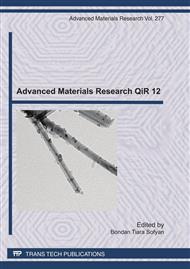p.1
p.11
p.21
p.27
p.36
p.43
p.51
p.59
Slowly Relaxing Structural Defects of Zinc Films with Excited States Induced by Ion Recombination Processes
Abstract:
In this paper we present experimental results with the ion recombination process in the vapor phase growth method. We consider the growth process of only one element case, Zinc, because of the clarification of the change of electron states in the element, not the entropy effect due to different elements. The advantages of using the ion recombination process are the following; 1) controllability of total energy, 2) the highest quenching rate, 3) locality of the collision. The total energy of the ion system was below 240 eV. Zn- ions exist on the growth front surface and Zn+ ones impinge to the growth surface from the vapor phase. The crystal structures of deposited zinc films are measured with the XRD system. Very strong diffuse scattering intensity of x-ray diffraction was observed at 10 eV, 90 eV, 100 eV and 230 eV after seven months “annealing” in room temperature from the preparation. These experimental facts suggest the effectiveness of the application of the excitation process of the inner core electron system as a new advanced material process. In this process, the ion recombination process and the existence of a metastable state are essentially important factors.
Info:
Periodical:
Pages:
11-20
Citation:
Online since:
July 2011
Authors:
Keywords:
Price:
Сopyright:
© 2011 Trans Tech Publications Ltd. All Rights Reserved
Share:
Citation:


